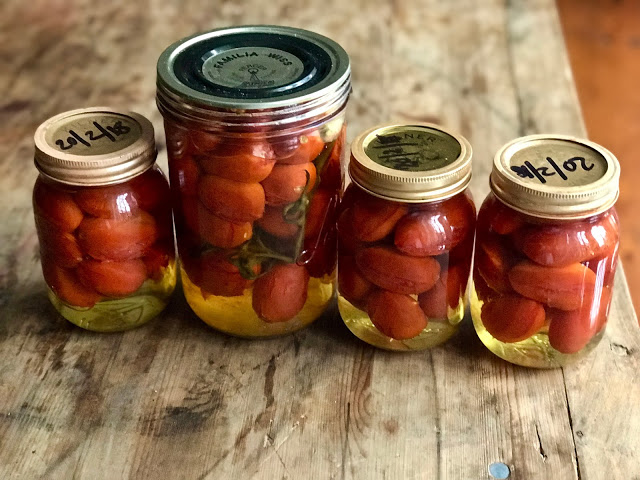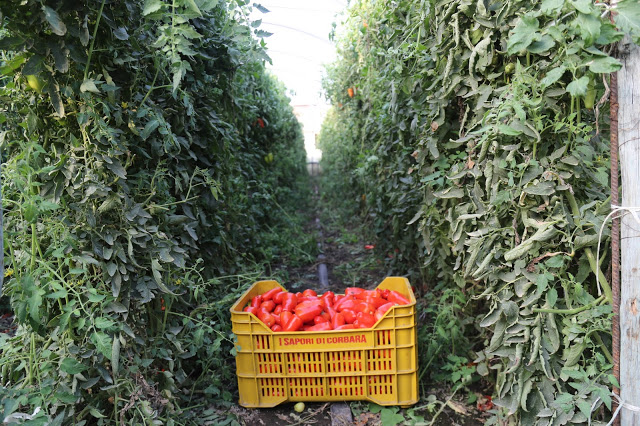This years heatwave has meant that most of us have been able to harvest our tomatoes early. By the end of September, English gardeners must pick the last tomatoes before they are blighted by damp British weather. You feel like you are drowning in tomatoes when the rush is on.
I planted mainly one variety last year, the tiny Red Pear, a lightbulb shape in an intense shade of red. My answer to using up the glut was a mixture of making passata (which can also be bottled using the same technique as below), sun-drying the tomatoes, or bottling the whole tomatoes. This way I had gorgeous ‘tinned’ tomatoes all winter, using techniques I learnt from I Sapori di Corbara, who were the winners of my Guardian taste test.
In the food business, tomatoes are judged by their Brix or sugar levels: good sauce tomatoes have a PH of 5 to 5.5 which means they are particularly sweet.
Recently I was sent Torpedino tomatoes by Delitalia, which are similar in size and shape to San Marzano, with a high Brix level.
Historically tomatoes were more acidic than today, which meant that when canning or bottling, the food was ‘safe’. You can pressure can tomatoes with a pH of under 4.6, but with modern sweeter cultivars you need to add bottled lemon juice or citric acid to prevent botulism.
How to can your tomato glut in 20 steps
What you will need:
I bought mine over the internet, it’s a Presto. Not to be confused with a pressure cooker.
Either Weck, Le Parfait, Ball, Mason or Kilner jars. I got lovely jars at Lakeland.
Make sure the orange rubber seals or the inserts of a two part lid are always new.
Rubber seals can be softened by putting them in boiling water briefly.
Pickling salt
To season the tomatoes
Citric Acid
To make sure the tomatoes have enough acidity to be safely preserved.
White vinegar:
A couple of drops in the water of the canner means that the jars won’t be stained.
Before you start:
Check the canner:
Tighten up screws.
Hold up the lid to daylight and make sure the pressure valve isn’t blocked.
The canning

1) Wash the tomatoes.
2) Pick over them and make sure they are not spoilt, bruised, split, or damaged.
I leave the skins on but if it’s a particularly thick skinned variety, blanch the tomatoes briefly and slip off the skins.
3) Sterilise the jars by putting them through a very hot wash on the dishwasher and or/ putting them in the oven for 15 minutes.
4) Calculate 1/2 tsp citric acid and 1tsp pickling salt for each 1/2 litre jar. Double that for a litre.
5) Pack the jars with the clean tomatoes.
6) Fill up the gaps around the tomatoes with hot water (or warm tomato sauce, made from the same tomatoes), leaving an inch headspace.
7) Using a sterile metal or plastic stick, slide it around the inside of the jars to remove any bubbles.
8) Put the two part lids on the jars, not too tight, hand-tight.
9) Fill the canner up to the lower mark with warm water.
10) Add a glug of white vinegar to the water.
11) Place jars in upright, with the rack underneath. Put the lid on the pressure canner and close, without the dial gauge.
12) On a steady heat, heat up the pressure canner till boiling, until steam starts to pop through the pressure valve. Then place the dial gauge on the valve. Bring up the pressure from 8 pounds to 10 pounds. Then lower the heat to keep it at 10 pounds.
13) Time your process, if you are at sea level, for ten minutes at ten pounds of pressure. Your Presto canner will rock gently. That’s ok, it’s normal. (If at any time the pressure is less than 10 pounds, you must start the count again.)
14) Remove from the heat or turn off the heat and leave to cool down and depressurise. Allow the pressure to drop naturally to zero.
15) After waiting till the pressure canner is at zero of pressure, has cooled, and that there is no more steam coming from the valve, wear oven gloves to open the pressure canner.
16) Remove the jars with a jar holder. Wait 12 to 24 hours for the jars to cool down.
17) Make sure the centre of the lids is concave. This is proof that the vacuum canning has worked. Remove the outer ring of the lid. If any of the jars have a convex lid, use within a couple of days.
18) Label the now dry jars with the product/date.
19) ‘Put up’ your jars and enjoy garden picked tomatoes as good as fresh all winter.
20) Turn into tomato sauce for pasta or pizzas.










Leave a Reply